Aquarium carpet plants are one of the most essential additions to the aquascaper’s toolbox.
They are used to fill in the foreground and create lush, verdant growth similar to a lawn. When given ample light and carbon dioxide many of these plants even create pearl-like bubbles of oxygen that fill the water column with delicate fizz.
Since they grow near the bottom, carpet plants sometimes need more light than other aquatic plants.
Many grow quickly while others are slow growing and need time to establish themselves.
Choosing the right aquarium carpet plant depends on both aesthetics and how much light and nutrients you can provide.
That’s why I’ve decided to discuss 15 species of aquarium carpet plants in order of easiest to the most difficult!
15 Aquarium Carpet Plants Ranked by Difficulty
Here are 15 of our favorite carpeting plants for aquariums
Java Moss
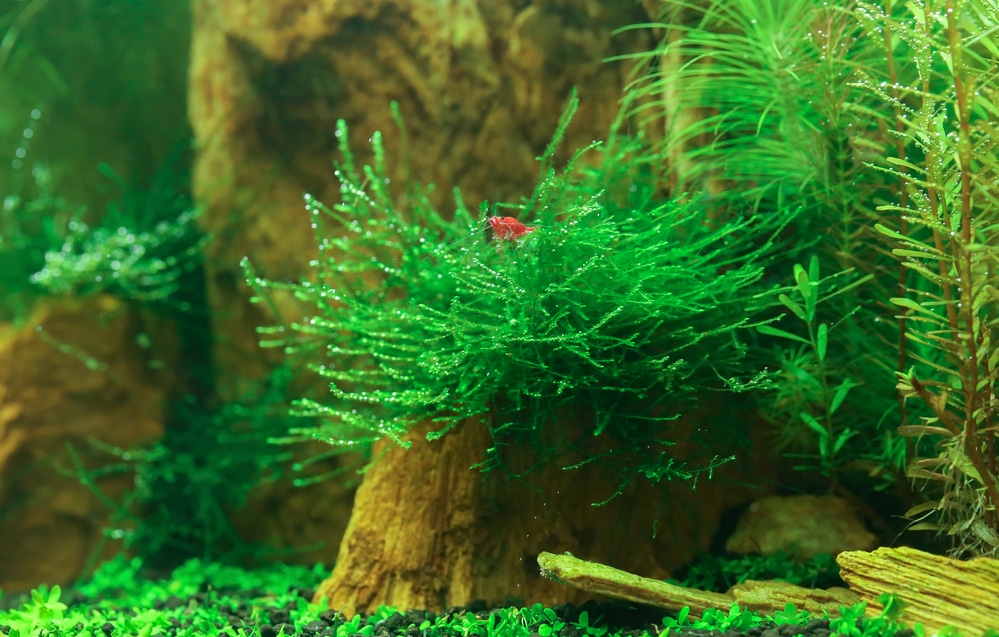
Easily found and almost impossible to kill, Java Moss is one of the best aquarium carpet plants for first time aquatic gardeners. Java Moss is incredibly versatile and can be used as a creeping fore or midground plant, attached to rocks and driftwood as an accent, or even allowed to float freely.
While it certainly appreciates it Java Moss does not require supplemental light, CO2, or fertilization. You should see rapid growth even using standard non-plant fluorescent lighting. Thanks to its thick, luxurious growth and undemanding nature Java Moss is often used as a spawning bed for fish eggs and fry to develop, safe from hungry mouths.
Propagating Java Moss is as simple as cutting pieces with sharp plant scissors and securing them to hard surfaces with dental floss or fishing line or lightly burying sections with substrate.
- Scientific name: Taxiphyllum barbieri
- Origin: Southeast Asia
- Growth Rate: Fast
- Supplemental CO2: Not Necessary
- Light Requirement: Low
Monosolenium tenerum
Liverworts are some of the oldest plant lineages on earth. Fossils date back as old as 470 million years. They also don’t have leaves per se; instead Liverworts have a “thallus,” a vegetative tissue that isn’t separated into leaves, stem, flower, etc.
Monosolenium tenerum is quite rare in nature and is an extremely unusual yet easy to keep plant, making it well worth using as an aquarium carpeting plant. It can also grow emersed which makes it suitable for paludariums as well.
Monosolenium tenerum sinks and uses rhizoids (similar to the rhizome of epiphyte plants) to attach to gravel, rocks, and driftwood. As it grows the thallus forks, creating a rippling, wavy cushion of dark green vegetation.
Monosolenium tenerum is quite similar to Crystalwort (Riccia fluitans) in appearance, as if it were magnified, darker, and larger. However, unlike Crystalwort, Monosolenium tenerum is very undemanding with a medium growth rate.
Rather than using roots it takes nutrients directly from the water column making it perfect for aquariums without enriched substrates. Monosolenium tenerum is a brittle plant, however, and will snap if vigorously disturbed.
- Scientific name: Monosolenium tenerum
- Origin: East Asia
- Growth Rate: Medium
- Supplemental CO2: Not Necessary
- Light Requirement: Low
Dwarf Sagittaria
How well Dwarf Sagittaria works as an aquarium carpet plant depends on what sort of conditions you provide. When given high lighting and a fertile substrate Dwarf Sagittaria will take on a clumped growth form. Since it doesn’t need to grow as high for light it will instead concentrate energy into sending runners laterally, cloning itself and forming a dense carpet of leaves 3 to 5 inches high.
If kept in low light environments Dwarf Sagittaria will grow as much as 12 inches tall and won’t work especially well as a carpeting plant. However it is a hardy mid to background plant in these conditions and can even grow in unfertilized substrates. Sagittaria subulata “Pusilla” (Dwarf Arrowhead) is a variety that stays especially small in all conditions but will wither if kept in low light environments.
Dwarf Sagittaria is also tolerant of both hard, alkaline water and even mildly brackish water. This makes it a rare foreground carpet plant suitable for brackish and Rift Lake aquariums.
- Scientific name: Sagittaria subulata
- Origin: Caribbean coast of North and South America
- Growth Rate: Fast
- Supplemental CO2: Not Necessary
- Light Requirement: Moderate
Cryptocoryne Parva
Cryptocoryne Parva is a little unusual compared to other Crypts. It has higher light requirements than its cousins, which tend to grow in the shade of tree canopies that cover slowly moving streams in Sri Lanka.
Without ample lighting it won’t have the energy to spread into a substrate covering carpet. Many Crypts also change color depending on lighting intensity but C. parva remains a light grassy green.
Like most Crypts C. parva grows fairly slowly, and this species rarely tops 4 cm in height. Supplemental fertilization and CO2 are helpful but given the slow growth rate of the plant good lighting is much more conducive to good health.
Given how low to the ground it grows Cryptocoryne parva never needs trimming. Once fully established it is an excellent low maintenance carpet plant for a mature aquarium with high lighting levels.
- Scientific name: Cryptocoryne parva
- Origin: Sri Lanka
- Growth Rate: Slow
- Supplemental CO2: Useful
- Light Requirement: High
Christmas Moss
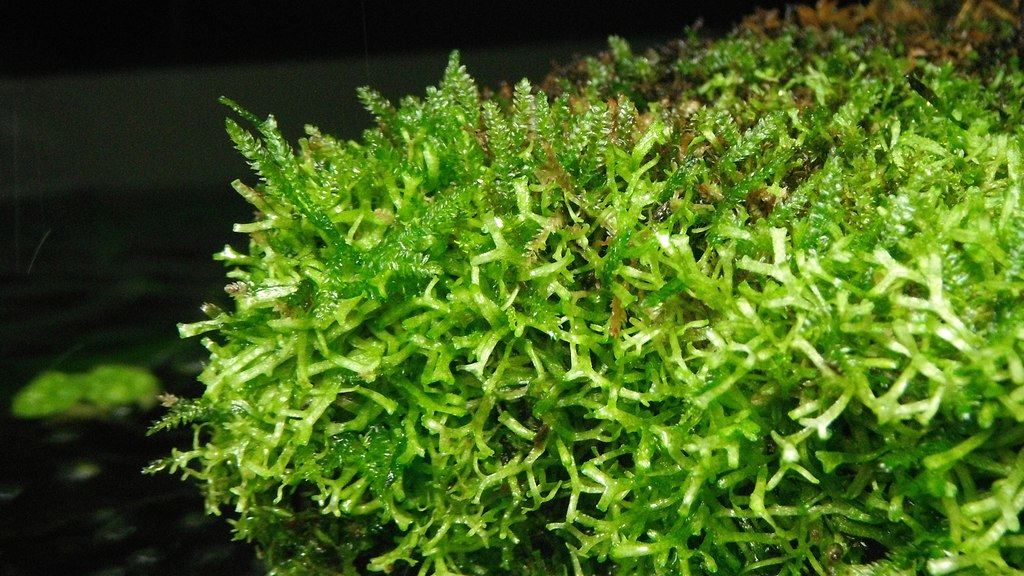
Christmas Moss is not as bullet-proof as Java Moss nor does it grow nearly as fast. It also has a more compact, branching growth pattern similar to a forest of fir trees, hence the name. The tiny leaves are rounder and grow at right angles relative to the stem. However if left unattached it takes on a more chaotic appearance similar to Java Moss.
In aquascaping Christmas Moss can be used to thickly carpet the foreground, rocks, and especially driftwood. Nature style aquascapes often use a canopy of Christmas Moss to mimic bonsai trees.
While it does not require much in the way of light and nutrients Christmas Moss grows best in medium to high lighting environments. Since it attaches to hard surfaces rather than uses true roots a rich substrate isn’t needed.
Supplemental CO2 also helps spur growth but even in the best of conditions it grows fairly slowly. Chrismas Moss also grows emersed and can be used as a carpet plant in paludariums.
- Scientific name: Vesicularia montagnei
- Origin: Southeast Asia and Australia
- Growth Rate: Slow
- Supplemental CO2: Useful
- Light Requirement: Medium to High
Dwarf Hairgrass
Also known as Dwarf Spikerush, Dwarf Hairgrass is a salt tolerant carpet plant that can grow both emersed and submerged. While it grows slightly faster above water it remains an excellent choice for aquascaping, so long as you follow a few tips to encourage it to spread.
Dwarf Hairgrass usually comes in potted clumps. While this is a natural growth form, if removed from the pot and set into the gravel it will rarely do much other than continue to photosynthesize and grow upwards.
Instead, we need to split our Dwarf Hairgrass into sections of 4 to 6 blades. Planting these mini-Hairgrass plants ½ to 1 inch apart in a fertile sand or fine gravel substrate will encourage them to spread without crowding one another.
Small grained sandy substrates work better than larger grain sizes for this species. Dwarf Hairgrass also takes up more nutrients via the roots rather than the water column.
While Dwarf Hairgrass tolerates low light levels moderate to high lighting is needed for it to carpet. Combined with trimming to keep it under 2 inches in height and you’ll have a fantastic aquarium lawn.
- Scientific name: Eleocharis parvula
- Origin: Northern Hemisphere
- Growth Rate: Moderate
- Supplemental CO2: Necessary
- Light Requirement: Moderate to High
Dwarf Water Clover
If Four Leaf Clover are lucky for you then try growing an entire carpet of them. Dwarf Water Clover is a small fern native to Africa and tropical Asia. It can be grown both emersed and submerged and underwater takes on a highly variable growing style depending on lighting.
So long as you provide high light levels Dwarf Water Clover will take on a carpet growth pattern perfect as a substrate creeper. However, when light levels grow dim it will shoot to the top and place leaves on the surface like lily pads.
CO2 isn’t required but encourages faster growth and reproduction. Dwarf Water Clover has several relations in the Marsilea genus with differing leaf shapes but similar requirements. All are excellent aquarium carpet plants when given ample lighting and a fertile substrate.
- Scientific name: Marsilea minuta
- Origin: Africa and Asia
- Growth Rate: Slow to Medium
- Supplemental CO2: Useful
- Light Requirement: High
Thai “Little Star” Plant
Called “Downoi” or “Little Star” in Thailand, Pogostemon helferi is a recent addition to the aquarium trade and is becoming very popular as an aquatic carpet plant. It’s closely related to the much more widely known Patchouli (Pogostemon cablin).
The light green leaves have intriguing crinkled edges and the entire plant has a starburst growth pattern. While tolerant of lower light levels keeping your light as strong as possible encourages Little Star to stay compact and channel energy into sending runners out into the substrate.
While very tolerant of a wide range of water conditions sudden fluctuations in chemistry can cause browning and death even if within normal parameters. Little Star also appreciates CO2 or liquid carbon for good growth and will slow down without supplementation.
Beware keeping it with plant-eating critters like Mollies or snails; Little Star has especially soft leaves and will be continually snacked upon.
- Scientific name: Pogostemon helferi
- Origin: Southeast Asia
- Growth Rate: Moderate
- Supplemental CO2: Necessary
- Light Requirement: Moderate to High
Crystalwort
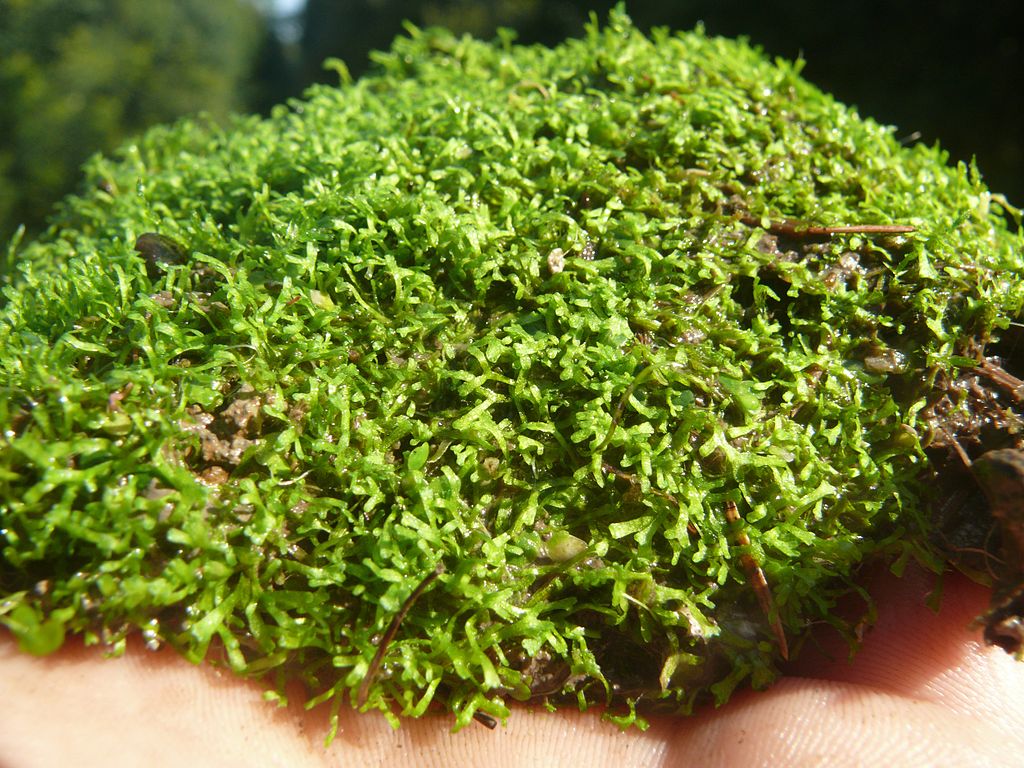
Crystalwort is one of those plants that appear intimidating because so many professionals use it in aquascaping that “it must be hard.” Quite the contrary! This attractive liverwort species is actually incredibly easy to grow so long as you provide for its needs. Crystalwort was popularized by Takashi Amano and is a classic plant for the Nature style aquascape.
Crystalwort in nature is most often found floating on the surface. This means your light levels need to be intense if you’re growing it as a submerged aquarium carpet plant, with a minimum of 2 to 3 watts per gallon. Supplementary CO2 and nutrients in the water column are also needed because Crystalwort doesn’t uptake food through roots.
When given rich conditions Crystalwort grows like a weed, creates attractive bubbles of oxygen as it photosynthesizes, and will need regular trimming. It has a fractal, crystal-like growth pattern that gives it its name.
Crystalwort can be attached to rocks and driftwood as well as grown along the substrate but needs to be tied down initially. It can also shade itself when kept in lower light environments, causing lower layers to brown if grown too thick, necessitating regular trims. Crystalwort is also a debris magnet and looks its best in well filtered water.
- Scientific name: Riccia fluitans
- Origin: Worldwide
- Growth Rate: Fast
- Supplemental CO2: Needed
- Light Requirement: Very High
Elatine hydropiper
Elatine hydropiper looks almost identical to Glossostigma elatinoides and is often considered to be an easier version of the latter plant. Both are aquarium carpet plants that form individual sprout-like plants that reproduce with runners.
Elatine hydropiper is slightly easier to maintain because it does not require as much light as Glossostigma and prefers cooler temperatures ranging from 60-75F. This makes it a great addition for ponds and unheated aquaria.
On the other hand, Elatine hydropiper is very hungry for CO2 and should be given liquid supplements and/or CO2 injections. Without supplemental CO2 it tends to yellow and eventually wither.
It has a medium growth rate compared to Glossostigma elatinoides but is just as beautiful once established. Lastly, Elatine hydropiper prefers soft water for lush growth.
- Scientific name: Elatine hydropiper
- Origin: Northern Eurasia
- Growth Rate: Medium
- Supplemental CO2: Needed
- Light Requirement: Moderate
Glossostigma elatinoides
Glossostigma elatinoides is especially popular in Japan aquascapes but comes from Southeast Australia and New Zealand. As a bog plant it grows in shallow water with a soft pH and alternates between flooding and exposure, flowering yearly.
The main issue with Glossostigma elatinoides is that it lives in such rich conditions that it is a very hungry aquarium carpet plant. If not given enough light it will reach towards the surface and no longer grow compact. Glossostigma needs intense lighting, CO2, and a fertile substrate to grow well.
In stores Glossostigma elatinoides come in tight bunches however individual plants should be broken up and planted approximately a centimeter from one another. You’ll need enough to cover at least 70% of the ground area you wish to carpet. Over the course of a month Glossostigma will fill in the area with verdant growth.
- Scientific name: Glossostigma elatinoides
- Origin: Australia and New Zealand
- Growth Rate: Fast
- Supplemental CO2: Needed
- Light Requirement: Very High
Dwarf Baby Tears
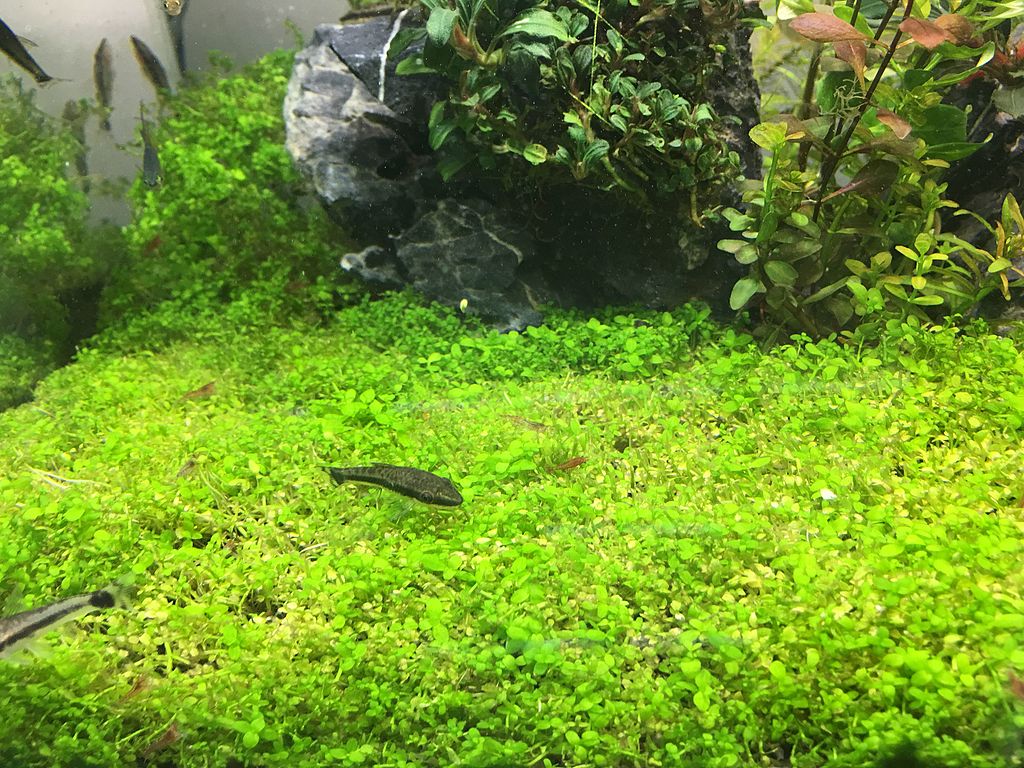
Dwarf Baby Tears is found only in Cuba and is one of, if not the, tiniest aquarium plants in the world. The leaves are only a few millimeters long and it grows normally along the water’s edge where it can be both submerged and emersed during the flood and dry seasons.
Dwarf Baby Tears need strong lighting and high CO2 in order to thrive. Given its small size and medium growth rate it takes some time to create a thick carpet. A rich substrate should also be provided to encourage runners to spread throughout.
So long as its given ample nutrients and time Dwarf Baby Tears will eventually fill the bare spots and carpet your aquarium. It should be purchased in moderate amounts and planted in clumps a few centimeters apart to aid in covering the substrate.
- Scientific name: Hemianthus callitrichoides
- Origin: Cuba
- Growth Rate: Medium
- Supplemental CO2: Needed
- Light Requirement: Moderate to High
Brazilian Micro Sword
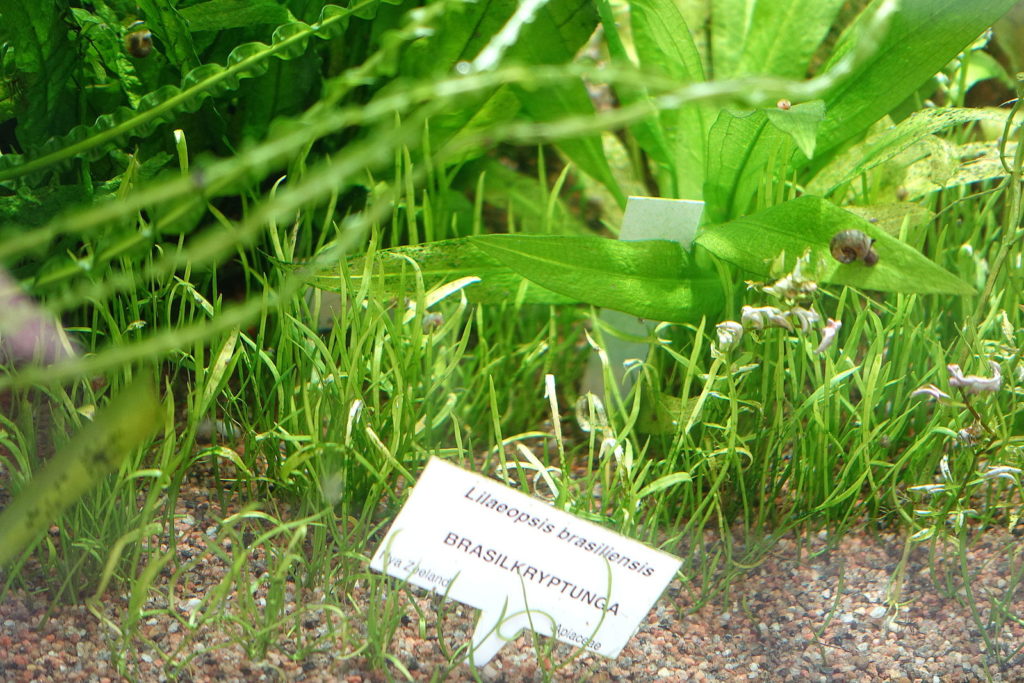
Also known as Copragrass, Brazilian Micro Sword is one of the best aquarium carpet plants for creating a grassy aquarium lawn. While commonly seen in pet stores it is unfortunately one of the more difficult aquarium carpet plants to care for.
Brazilian Micro Swords need high light, CO2 supplementation and most importantly, a fine substrate rich in nutrients to spread. Sand enriched with root tablets and organics or even soil based planting substrates will encourage heavy if not rapid growth.
Brazilian Micro Sword forms runners that eventually carpet the foreground but take some time to get established. It should be broken up into small clumps and planted across the substrate to speed growth. It can also be grown in brackish conditions.
Micro Swords don’t appreciate being shaded and larger plants need to be carefully chosen to avoid stunting its growth..
- Scientific name: Lilaeopsis brasiliensis
- Origin: South America
- Growth Rate: Slow
- Supplemental CO2: Needed
- Light Requirement: High
Blyxa Japonica
Blyxa japonica is a great carpet plant for aquarists who like a bit of a challenge. Found throughout the tropical portions of Asia, it has a shrubby appearance and grows taller than most of the plants here, creating an especially dense carpet over time.
While it will grow into a tight bush and carpet the surrounding area Blyxa japonica is not especially fast growing nor does it spread as well as some of the other plants. It is best planted in groups throughout the substrate and allowed to fill in over time.
Blyxa japonica is very fussy in terms of water and nutrient parameters, preferring soft, acidic water, a rich substrate, CO2 supplementation and high lighting levels.
When given all of the above Blyxa japonica not only grows compact but takes on a golden to reddish hue that’s unique among aquarium carpet plants. If any one factor is missing it will remain green or even die off.
If not given enough light or shaded by larger plants Blyxa will start to grow taller, straining for more. When allowed to grow taller Blyxia is a great midground plant as well.
- Scientific name: Blyxa japonica
- Origin: South and East Asia
- Growth Rate: Medium
- Supplemental CO2: Needed
- Light Requirement: Very High
Utricularia Graminifolia
Utricularia graminifolia is a species of Bladderwort, carnivorous plants that use small traps to capture aquatic prey. Hair-like triggers are activated upon touch and suck nearby organisms within to be digested over time. Thankfully, the traps of U. graminifolia are quite tiny, allowing it to feed on free floating infusoria and plankton but not small fish or shrimp.
The need to feed combined with its unique growing conditions make Utricularia graminifolia one of the harder plants on this list. The main challenge is that you can’t grow U. graminifolia like other aquarium carpet plants.
It doesn’t use true roots and prefers to either float or attach to hard surfaces. However it does create runners and will thread itself throughout the substrate. U. graminifolia will also attach to hard surfaces and eventually carpet them with growth.
Utricularia graminifolia also prefers nutrient poor substrates as it eats aquatic organisms rather than use fertilizer. Lastly, acidic conditions are needed – like most carnivorous plants U. graminifolia grows in boggy environments. Substrates enriched with peat help maintain water chemistry to its liking.
- Scientific name: Utricularia graminifolia
- Origin: Southeast Asia
- Growth Rate: Slow
- Supplemental CO2: Useful
- Light Requirement: Medium to High


Beautiful plants. What is the purple looking carpet plant?